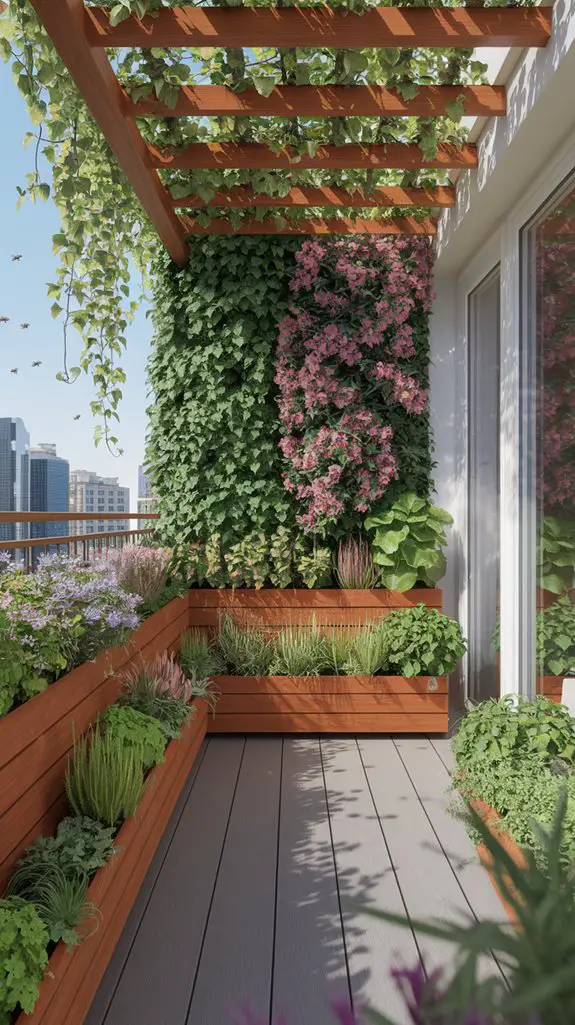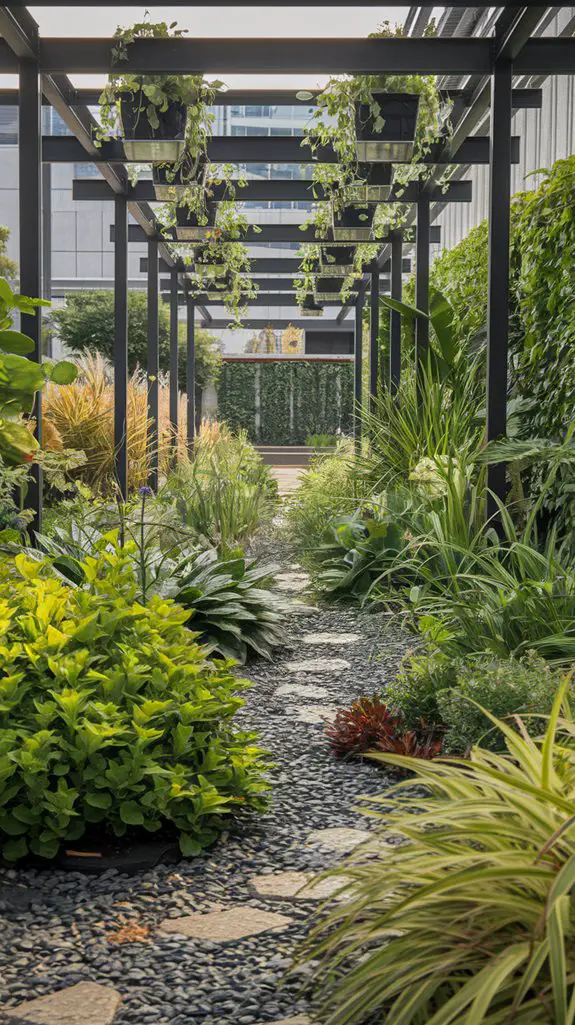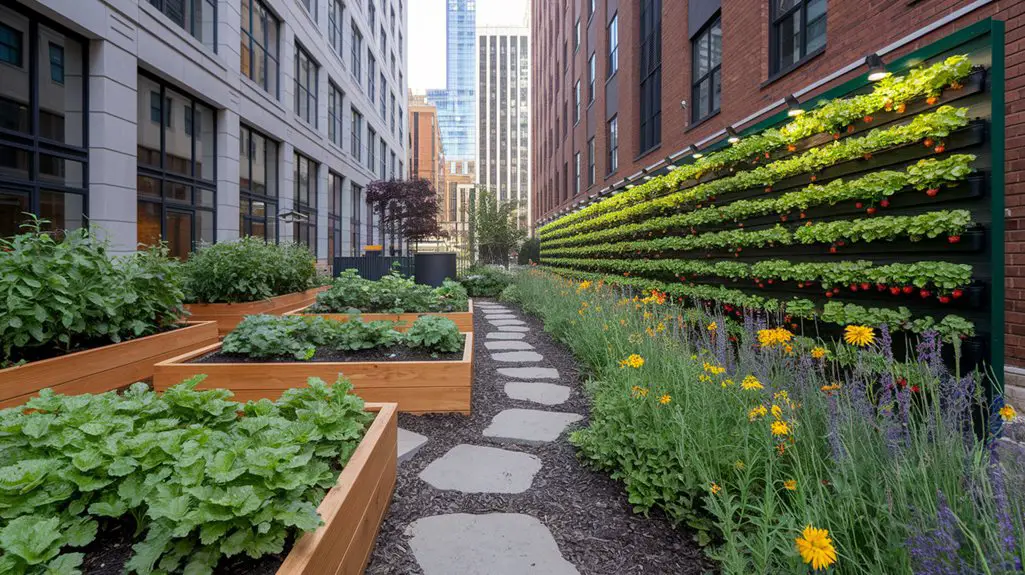You'll find sustainable urban gardens at the intersection of ecology and design, where every element serves multiple purposes. These gardens thrive through strategic native plant selection, which naturally supports local biodiversity while requiring minimal resources. By implementing vertical gardening techniques, you can maximize limited space while enhancing air circulation and sunlight exposure. Water conservation systems, healthy soil practices, and intentional micro-habitats transform concrete jungles into vibrant ecosystems. The question remains: how might these principles reshape your own urban landscape?
Selecting Native Plants for Urban Ecosystems
When designing sustainable urban gardens, selecting native plants should be your primary consideration due to their adaptation to local climate conditions and soil types.
Native species require less water, fertilizer, and maintenance than exotic varieties, making them ideal for resource-conscious urban settings.
Begin by researching plants indigenous to your region. Consider your specific microclimate—factors like sun exposure, drainage, and available space will influence suitable choices.
Select species that provide year-round interest and support local wildlife, especially pollinators.
You'll find that native plants form natural communities when properly grouped.
Create these plant communities by mimicking natural patterns of your region's ecosystems. This approach enhances resilience against pests and disease while maximizing ecological benefits in limited urban spaces. Additionally, incorporating wildlife habitats can significantly boost biodiversity and improve the overall health of your urban garden.
Maximizing Small Spaces Through Vertical Gardening

Urban living often presents space constraints that limit gardening possibilities, but vertical gardening offers an efficient solution for maximizing growing capacity.
You'll need to utilize walls, fences, and railings by installing trellises, hanging planters, and wall-mounted containers.
Select appropriate plants for vertical systems—vining vegetables like cucumbers and beans, or trailing herbs such as thyme and oregano work exceptionally well.
Consider weight distribution and secure all structures properly to prevent accidents. Integrate drip irrigation systems to guarantee consistent watering without waste.
For ideal resource efficiency, place sun-loving plants at the top where they'll receive maximum light, while shade-tolerant species can thrive below.
Remember that vertical gardens create microclimates—top areas typically remain drier and warmer than bottom sections. Additionally, incorporating vertical garden solutions not only enhances aesthetic appeal but also promotes biodiversity in urban environments.
Water Conservation and Rainwater Harvesting Systems

Water conservation stands as a critical component of sustainable urban gardening, particularly as climate change intensifies water scarcity in many regions.
You'll reduce consumption greatly by installing drip irrigation systems that deliver water directly to plant roots, minimizing evaporation and runoff.
Rainwater harvesting offers an elegant solution to water independence. Connect downspouts to rain barrels or cisterns to capture precipitation from your roof. A typical 1,000-square-foot roof can collect approximately 600 gallons from just one inch of rainfall. This stored water can irrigate your garden during dry periods.
Consider implementing greywater systems that redirect wastewater from sinks or showers to your garden beds.
Install moisture sensors to prevent overwatering, and apply mulch liberally to retain soil moisture and suppress water-hungry weeds. Additionally, incorporating creative rainwater collection methods can enhance your garden's sustainability by maximizing water usage efficiency.
Building Healthy Soil in Limited Urban Environments
Healthy soil forms the foundation of any successful garden, yet urban environments often present significant challenges in this regard. You'll frequently encounter compacted, depleted, or contaminated soil in city settings.
Start by testing your soil's pH and nutrient levels to establish a baseline. Implement sheet mulching to build soil without digging: layer cardboard, compost, and organic matter directly on existing ground.
Add diversity through regular applications of compost, worm castings, and leaf mold. These amendments improve structure, water retention, and microbial activity. Container gardening allows for greater flexibility in location and can enhance the overall soil quality when using high-quality potting mixes.
For contaminated sites, consider raised beds with imported soil or container gardening. Maintain soil health by practicing crop rotation, avoiding walking on beds, and incorporating cover crops during off-seasons to prevent erosion and add organic matter.
Creating Micro-Habitats for Urban Wildlife and Pollinators
While gardens provide us with beautiful spaces and food, they can also serve as essential sanctuaries for local wildlife and pollinators that face habitat loss in urban environments.
To create effective micro-habitats, incorporate diverse native plants that flower at different times throughout the season. Install a small water feature—even a shallow dish will attract birds and beneficial insects. Leave some areas unmulched with bare soil for ground-nesting bees.
Stack rocks to create crevices for lizards and beneficial insects. Hollow stems and small bundles of twigs provide nesting sites for solitary bees. Consider adding a bat box to support these natural pest controllers.
Don't remove all fallen leaves in autumn; they create overwintering habitats for many beneficial insects. Additionally, planting native species enhances the ecological value of your garden and ensures that the local wildlife has the resources they need to thrive.
Even small balcony gardens can support pollinators with the right plant selection and micro-features.
Composting and Organic Waste Management for City Gardens
Three core principles underpin effective composting in urban settings: space efficiency, odor management, and accelerated decomposition.
You'll need compact solutions like tumbling composters or bokashi systems that fit on balconies or under sinks. These systems prevent odors that might disturb neighbors while processing food scraps efficiently.
To accelerate decomposition, maintain proper carbon-to-nitrogen ratios (3:1) by mixing brown materials (cardboard, dried leaves) with green materials (food scraps, coffee grounds).
Chop materials into smaller pieces for faster breakdown. Add finished compost to container gardens as a nutrient-rich amendment, reducing the need for synthetic fertilizers.
Collect rainwater to moisten your compost when needed, creating a closed-loop system that transforms waste into valuable garden resources while diverting organic matter from landfills. Additionally, incorporating renewable resources into your composting strategy can enhance sustainability in your urban garden.
Edible Landscaping: Growing Food in Urban Settings
Edible landscaping transforms urban spaces by integrating food-producing plants into decorative settings, creating functional and beautiful environments. You'll maximize limited space by selecting plants that serve multiple purposes—providing food while enhancing aesthetics. Incorporating edible landscaping ideas can further enrich your gardening experience and enhance urban biodiversity.
| Plant Type | Space Requirement | Yield Potential |
|---|---|---|
| Herbs | Minimal (pots) | High/Continuous |
| Vegetables | Medium (beds) | Seasonal/High |
| Fruit Trees | Large (10+ sq ft) | Annual/Medium |
Choose vertical growing systems for vining crops like cucumbers and beans to save ground space. Incorporate edibles into existing ornamental beds—rainbow chard and kale offer colorful alternatives to traditional flowers. Consider container gardening for balconies and patios, using self-watering systems to reduce maintenance. Remember to position plants according to sunlight requirements, typically 6-8 hours daily for most edibles.
Reducing Environmental Impact With Sustainable Materials
Selecting appropriate materials for your urban garden greatly reduces environmental impact while extending the lifespan of your growing spaces.
Choose reclaimed wood or composite lumber made from recycled plastics for raised beds instead of pressure-treated options containing harmful chemicals.
Opt for biodegradable pots made from coconut coir, compressed rice hulls, or recycled paper instead of petroleum-based plastic containers.
For pathways, consider permeable materials like gravel or recycled rubber mulch that allow water infiltration rather than concrete that increases runoff.
When selecting trellises and supports, explore bamboo stakes, recycled metal frames, or repurposed household items.
Install rain barrels beneath downspouts to collect water, reducing dependence on municipal supply.
Incorporating eco-friendly options for your backyard decking can further enhance the sustainability of your urban garden.
These sustainable material choices minimize your carbon footprint while creating an urban garden that aligns with ecological principles.
Conclusion
You'll find that sustainable urban gardening doesn't require complex systems—just thoughtful planning. As you're selecting native plants, coincidentally you're also creating wildlife habitats. By implementing vertical gardening and rainwater harvesting, you're maximizing both space and resources. Your composting efforts build soil health while reducing waste. Remember, sustainability isn't just about environmental impact; it's about creating a resilient ecosystem that thrives with minimal intervention in your limited urban space.




